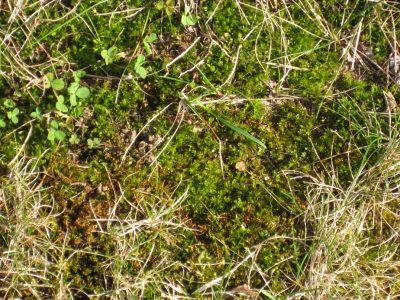Each year, a lawn problem that many homeowners complain about is moss. Moss is a plant from the botanical phylum Briophata. Homeowners often ask a number of questions concerning moss. Three of the more commonly asked questions are: what is wrong with moss, what causes moss, and how do I get rid of or control moss? To answer the first question let us first define a weed. A weed is a plant that is not wanted or out of place. If you desire moss, then it is not considered a weed. In fact, there are a number of garden centers that sell moss for gardens and landscapes. While some consider it a ‘weed’ others rather like it. After all, it is always green, and it never needs mowing!
Like most weeds, moss invades where turf density is low. Reduced density can be the result of a number of factors that include natural causes or improper turfgrass management practices. Natural causes may include burrowing animals, lawn eating insects, insufficient sunlight, lack of air movement, low soil pH, and high water tables. Examples of improper management practices include poor soil fertility, soil compaction, over watering, improper mowing heights, and the selection of improper grass varieties during lawn establishment.
Moss control is often difficult. While there are many pesticides labeled for moss control, the best way to eliminate moss is to correct the problem(s) that led to moss invasion in the first place. Otherwise, moss will continue to invade the site.
The first step to moss control is to promote healthy dense turf through proper turfgrass management. Soil samples should be taken and sent to a soil laboratory for analysis. A common misconception is that applications of limestone will control moss. This is not always the case. While an application of limestone may reduce moss on acidic soils, an application of limestone may aggravate moss problems on alkaline soils. A soil test will provide homeowners with the information needed to properly balance soil fertility and adjust the soil pH. If soils are compacted, aerate to improve plant health and vigor.

In many cases, moss appears in lawns where sunlight is lacking or where there is a lack of air movement. Tree pruning, clearing underbrush, or selected tree removal will improve the growing conditions for the grass. Tree removal is not an easy option for the homeowner. What it comes down to in many cases is that a decision has to be made between a tree and grass. Often times in lawns that are shaded by trees, selective removal and pruning will provide positive results. When growing grass in a shaded environment it is important to select grasses that perform well under these conditions. Recommended cool season grasses that exhibit a degree of shade tolerance include species such as creeping red fescue and chewing fescue. Roughstalk bluegrass is also an option when conditions are wet. However, it is important to realize that under extremely shady conditions, grass will not perform well. In these cases, alternatives to grasses such as pachysandra, myrtle, ferns, epimediums or other groundcovers should be considered.
Another factor that can encourage moss invasion is over watering or poor drainage. Monitor soil moisture levels prior to watering your lawn. When utilizing an underground sprinkler system, the irrigation system should be designed in such a way that allows areas of the lawn (in the shade) to be turned off or run times reduced. Automatic sprinkler systems should have ‘rain out’ switches that will automatically shut off sprinklers during rain events. Over watering will result in a thinning of the turfgrass canopy that will allow moss to invade. Lawns that are established on high water tables may require the installation of subsurface drainage.
Moss removal can be accomplished by using mechanical means such as aggressive raking with a steel rake or by the use of chemicals labeled for moss control. Chemical products available include iron sulfate, copper sulfate, fatty-acid soaps, and potassium salts. Be sure to read the label before making applications. Some of the available products can be phytotoxic to the desired turf and should not be applied at rates higher than specified on the label.
In general, moss control products may have immediate effects but in the long term, it is important to realize that killing or removing the moss and failing to correct the conditions that favor it will only result in its re-invasion.
By Steven Rackcliffe, Emeritus Extension Instructor, Department of Plant Science & Landscape Architecture. 2017.
Questions? Contact:
UConn Soil Nutrient Analysis Laboratory
Department of Plant Science and Landscape Architecture
Phone: 860.486.4274
Email: soiltest@uconn.edu
Website: soiltesting.cahnr.uconn.edu
UConn is an equal opportunity program provider and employer.
©UConn Extension. All rights reserved.